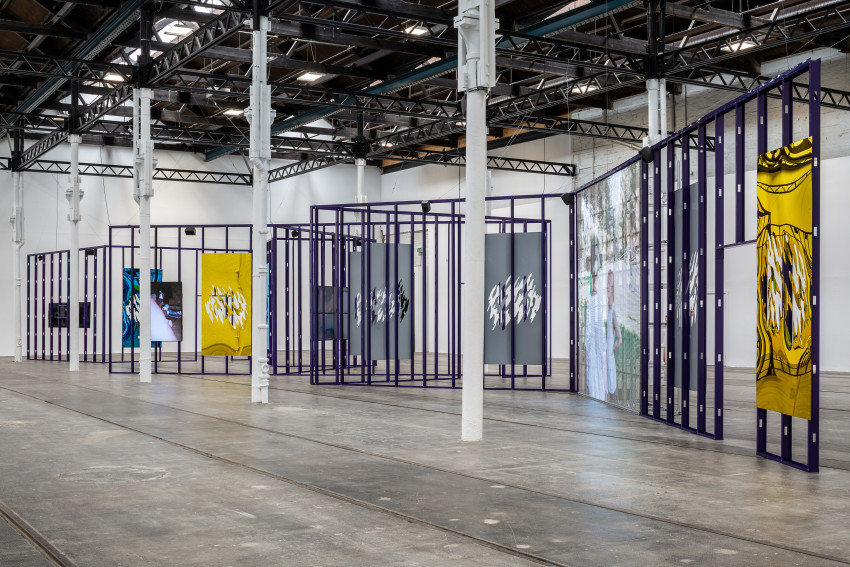Rachel Willcocks, the inaugural Glasgow International/ArtReview writer in residence, considers a series of works that unearth the systemic inequality that haunts Black American aspirations

At the entrance to Martine Syms’s immersive multi-video installation She Mad at Glasgow’s Tramway, I heard a familiar tune: the soundtrack to one of my favourite TV shows, the all-Black-led female sitcom Girlfriends (2000-8).
Across nine metal stud-wall frames which, painted purple, zigzag through the gallery, four blocks of flatscreen monitors are mounted and play consecutively. As well as Girlfriends, clips from The Fresh Prince of Bel-Air (1990–6), Black-ish (2014–) and The Cosby Show (1984–92) feature in Syms’s two-channel video S1:E1 A Pilot for a Show About Nowhere (2015). The video is a visual essay interspersed with GIFs of our favourite Black characters. Via a voiceover, Syms talks through the history, importance of and development of the Black sitcom. Even through the gaze of a Black-Brit, these shows resonated: they offered a fantasy – the Black American dream, an alternative to the Black experience in reality. Simultaneously, they offer an example of the thriving ideals of Americanism that contrast with the lack of aspirational representations of Blackness in Britain – other than Desmond’s (1989–94). Throughout the video, there are ‘commercial breaks’ during which Syms interviews young Black Americans about the first time they owned a television. Such anecdotes create a space in which to dream about the attainability of the worlds and lifestyles presented by those shows.

Next to the videoworks are vivid blue and yellow mirrors with melting cut-out effects that act as a guise to disfigure audiences’ reflections. Standing in front of the distorted image of oneself provokes an introspective questioning and searching around identity that continues throughout the exhibition. Ambiguity runs throughout Intro to Threat Modeling (2017) a collage of short, overlapping media clips and a stream-of-consciousness style of narration. While Syms reads out emails (which include a copious amount of tedious email etiquette) and probes questions around her identity in relation to the process of ‘threat modelling’ (a form of risk assessment that looks at how safeguards can mitigate potential threats, including vulnerabilities), the video shows notes from academic papers, screenshots of instant messages, photographs, video and self-shot footage, alongside a personalised avatar of Syms who inhabits an empty VR space. At one point, the avatar dances around as Syms repeatedly asks “Who am I?”, eventually spiralling into a defensive rant. Intro to Threat Modeling questions where Black identities belong online but also signals vulnerability, online threats and the protective yet misunderstood trope of the ‘strong Black girl’.

History repeats itself in Syms’s four-channel video Laughing Gas (2016). Titled after Edwin Porter’s 1907 short comedy film, featuring one of the earliest screen performances by a Black female actress, Bertha Regustus, Laughing Gas morphs into a kind of madness. Switching from four separate channels to one large picture, this time we see Syms play the main character who, after visiting the dentist, is given laughing gas to help with the pain of her wisdom tooth removal. Uncontrollable laughter takes over. Awkwardness arises when it turns out the insurance plan doesn’t cover the costs. It hints at systemic inequality, deep-rooted and stemming from slavery. The surroundings complement the work too; beneath Syms’s installation the building’s origins reflect a city built off the back of wealth accrued by links to the slave trade – the remnants of the nineteenth-century tram-track lines embedded in the floor a reminder of this history.
The last video work, S1:E4 (2020), takes a sitcom format. This melodramatic episode follows the character of Martine again: beginning with a micro-aggression at a party, the film then flashes back to Syms at a summer camp for teenage girls led by a Black supermodel (named B-B-Q!). During an inspirational talk at the summer camp audio glitches interrupt the speech, the sound becomes distant and the voice distorted and unrecognisable – but only for a few seconds each time. Later on the girls are asked to play a game where they uncomfortably spurt out insulting racial stereotypes; the video’s aesthetic changes to match the tone of dark humour as the lighting dims and the acting becomes both frantic and dramatic. Throughout, Syms balances humour and an underlying fragility. She Mad is an accumulation of the complexities within the Black subconsciousness and an insight into how we interpret and mould our identities to suit different environments. After watching the videos, we are left again with the sculpture, the mirrors and our part-visible, part-cutout reflections before the cycle repeats itself and the credits of She Mad, music intro and all return.
Martine Syms: She Mad, at Tramway, Glasgow, 11 June – 25 July